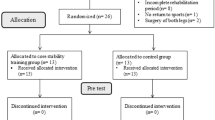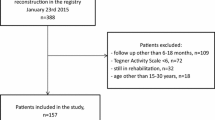Abstract
Open kinetic chain (OKC) knee extensor resistance training has lost favour in rehabilitation of patients with knee ACLD due to concerns that this exercise is harmful to the remaining portion of the ACL and its secondary stabilizers, and will be less effective in improving function. In this randomized, single-blind clinical trial, closed and OKC knee extensor training were compared for their effects on knee laxity and function in patients with ACLD knees. Sixty-four patients with a diagnosis of knee ACLD (49 M, 15 F; mean age=30 years) were measured for knee laxity, using a ligament arthrometer, and function with the Hughston Clinic knee self-assessment questionnaire and maximal effort single leg jump testing. Between the above tests and identical tests carried out 6 weeks later, subjects trained using either open or closed kinetic chain resistance of their knee and hip extensors as part of formal physical therapy sessions three times per week for 6 weeks. The groups exhibited no statistically significant differences (p<0.083) in outcome. These results indicate that knee extensor OKC training, as used in this study, can be safely applied to patients with knee ACL deficiency, and shows no superiority to CKC training.
Similar content being viewed by others
References
Anderson M, Foreman T (1996) Return to competition: functional rehabilitation. In: Zachazewski J, Magee D, Quillen W (eds) Athletic injuries and rehabilitation, chap 13. Saunders, Philadelphia, pp 229–261
Arms SW, Pope MH, Johnson RJ, Fischer RA, Arvidsson I, Eriksson E (1984) The biomechanics of anterior cruciate ligament rehabilitation and reconstruction. Am J Sports Med 12:8–18
Augustsson J, Esko A, Thomee R, Svantesson U (1998) Weight training of the thigh muscles using closed vs open kinetic chain exercises: a comparison of performance enhancement. J Orthop Sports Phys Ther 27:3–8
Beynnon BD, Fleming BC (1998) Anterior cruciate ligament strain in-vivo: a review of previous work. J Biomech 31:519–525
Booher LD, Hench KM, Worrell TW, Stikeleather J (1993) Reliability of three single-leg hop tests. J Sport Rehab 2:165–170
Borsa PA, Lephart SM, Irrgang JJ (1998) Comparison of performance-based and patient-reported measures of function in anterior-cruciate-ligament-deficient individuals. J Orthop Sports Phys Ther 28:392–9
Brosky JAJ, Nitz AJ, Malone TR, Caborn DN, Rayens MK (1999) Intrarater reliability of selected clinical outcome measures following anterior cruciate ligament reconstruction. J Orthop Sports Phys Ther 29:39–48
Bynum EB, Barrack RL, Alexander AH (1995) Open versus closed chain kinetic exercises after anterior cruciate ligament reconstruction—a prospective randomized study. Am J Sports Med 23:401–406
Clark NC, Gumbrell CJ, Rana S, Traole CM, Morrissey MC (2002) Intratester reliability and measurement error of the adapted cross-over hop for distance. Phys Ther Spor 3:143–151
De Vita P, Hortobagyi T, Barrier J, Torry M, Glover KL, Speroni DL, Money J, Mahar MT (1997) Gait adaptations before and after anterior cruciate ligament reconstruction surgery. Med Sci Sports Exerc 29:853–859
Gaunt BW, Curd DT (2001) Anthropometric and demographic factors affecting distance hopped and limb symmetry index for the crossover hop-for-distance test in high school athletes. J Orthop Sports Phys Ther 31:145–151
Greenberger HB, Paterno MV (1995) Relationship of knee extensor strength and hopping test performance in the assessment of lower extremity function. J Orthop Sports Phys Ther 22:202–206
Henning CE, Lynch MA, Glick KR (1985) An in vivo strain-gauge study of elongation of the anterior cruciate ligament. Am J Sports Med 13:22–26
Hooper DM, Morrissey MC, Drechsler WI, Morrissey D, King JB (2001) Open and closed kinetic chain exercises in the early period after ACL reconstruction: improvements in level walking, stair ascent and descent. Am J Sports Med 29:167–174
Maitland GD (1991) Peripheral manipulation, 3rd edn. Butterworth-Heinemann, Oxford, pp 240–255
Mikkelsen C, Werner S, Eriksson E (2000) Closed kinetic chain alone compared to combined open and closed kinetic chain exercises for quadriceps strengthening after anterior cruciate ligament reconstruction with respect to return to sports: a prospective matched follow up study. Knee Surg Sports Traumatol Arthrosc 8:330–342
Morrissey MC, Hudson ZL, Drechsler WI, Coutts FJ, King JB, McAuliffe TB (2000) Correlates of knee laxity change in early rehabilitation after anterior cruciate ligament reconstruction. Int J Sports Med 7:529–535
Morrissey MC, Hudson ZL, Drechsler WI, Coutts FJ, Knight PR, King JB (2000) Effects of open versus closed kinetic chain training on knee laxity in the early period after anterior cruciate ligament reconstruction. Knee Surg Sports Traumatol Arthrosc 8:343–348
Noyes FR, Mooar LA, Barber SD (1991) The assessment of work-related activities and limitations in knee disorders. Am J Sports Med 19:178–188
Palmitier RA, An K, Scott SG, et al (1991) Kinetic chain exercise in knee rehabilitation. Sports Med 402–413
Petschnig R, Baron R, Albrecht M (1998) The relationship between isokinetic quadriceps strength test and hop tests for distance and one-legged vertical jump test following anterior cruciate ligament reconstruction. J Orthop Sports Phys Ther 28:23–31
Queale WS, Snyder-Mackler L, Handling KA, Richards JG (1994) Instrumented examination of knee laxity in patients with anterior cruciate deficiency - a comparison of the KT-2000, Knee Signature System, and Genucom. J Orthop Sports Phys Ther19:345–351
Robertson DGE, Fleming D (1987) Kinetics of standing broad and vertical jumping. Can J Sport Sci - Revue Canadienne des Sciences du Sport 12:19–23
Shelbourne KD, Nitz P (1992) Accelerated rehabilitation after anterior cruciate ligament reconstruction. J Orthop Sports Phys Ther 15:256–264
Solomonow M, Baratta R, Zhou BH et al (1987) The synergistic action of the anterior cruciate ligament and thigh muscles in maintaining joint stability. Am J Sports Med 15:207–214
Staubli HU, Jakob RP (1991) Anterior knee motion analysis - measurement and simultaneous radiography. Am J Sports Med 19:172–177
Steinkamp LA, Dillingham MF, Markel MD et al (1993) Biomechanical considerations in patellofemoral joint rehabilitation. Am J Sports Med 21:438–444
Van Lent MET, Drost MR, Wildenberg FAJ (1994) EMG profiles of ACL-deficient patients during walking: the influence of mild fatigue. Int J Sports Med 15:508–514
Witvrouw E, Lysens R, Bellemans J, Peers K, Vanderstraeten G (2000) Open versus closed kinetic chain exercises for patellofemoral pain - a prospective, randomized study. Am J Sports Med 28:687–94
Yack HJ, Collins CE, Whieldon TJ (1983) Comparison of closed and open kinetic chain exercise in the anterior cruciate ligament-deficient knee. Am J Sports Med 21:49–54
Acknowledgements
This study was supported by grants from Action Medical Research and the Special Trustees of the Royal London Hospitals Trust. The authors thank the following for their assistance with this project: Renata Vauhnik, Ivy Man, Peter Milligan, Bruce Paton, Jo Jones and Technogym UK.
Author information
Authors and Affiliations
Corresponding author
Appendices
Appendix 1
Page from the diary for recording activities undertaken outside therapy
Subject Number:____ Date: ____ Please complete the following tables on a daily basis (you should have been given enough of these sheets so you have one for each day of the study period):
Appendix 2
Questionnaire for detecting patient bias resulting from communication with their clinician
Date: ____ Please note that this questionnaire is anonymous. Any responses you make will be kept in the strictest confidence. Your clinician will not be told of your specific responses. The responses will help us better understand the results from this study. Please answer the following questions as accurately as possible.
-
1.
Please tick which one of these two exercises you performed during the study:
-
leg press (lying on back and pushing against plate)
-
knee extension (sitting on a bench and lifting a weight placed against your shin)
-
-
2.
During the study, were you ever given the impression that these two exercises differed in terms of how good they were?
-
Yes (please answer all the following questions)
-
No (please answer questions 5 and 6 only)
-
-
3.
Which of the two exercises was the so-called “better” one?
-
leg press ((lying on back and pushing against plate)
-
knee extension (sitting on a bench and lifting a weight placed against your shin)
-
-
4.
Please describe who or what gave you the impression that one exercise was better than the other: ____________ ____________ ________
-
5.
Please tick the hospital where you had physiotherapy: Mile End The Whittington Whipps Cross St Thomas’s
-
6.
Please state the name(s) of the physiotherapist(s) who treated you during the study: ____________ Thank you for taking the time to complete this questionnaire.
Rights and permissions
About this article
Cite this article
Perry, M.C., Morrissey, M.C., Morrissey, D. et al. Knee extensors kinetic chain training in anterior cruciate ligament deficiency. Knee Surg Sports Traumatol Arthrosc 13, 638–648 (2005). https://doi.org/10.1007/s00167-004-0603-8
Received:
Accepted:
Published:
Issue Date:
DOI: https://doi.org/10.1007/s00167-004-0603-8




